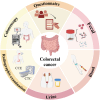Comprehensive evaluation and progress of colorectal cancer screening methods
- PMID: 41013540
- PMCID: PMC12466027
- DOI: 10.1186/s13099-025-00751-y
Comprehensive evaluation and progress of colorectal cancer screening methods
Abstract
The evolution of colorectal cancer (CRC) follows a progression from polyp to adenoma and eventually to cancer. The implementation of CRC screening is an effective strategy to interrupt the disease process and reduce morbidity and mortality during this process. Early diagnosis and treatment of tumors can be facilitated through widespread screening campaigns, thereby reducing the economic burden on the state, society and families. In order to achieve this goal, the key lies in the development of screening methods that are both efficient and economical to ensure that they can be widely disseminated and minimize the rate of missed diagnoses. At home and abroad, numerous scholars and experts have devoted themselves to the study of CRC screening methods. This review synthesizes current evidence through a systematic literature review to evaluate existing CRC screening methodologies, thereby offering critical insights to inform clinical decision-making in optimizing screening strategy selection.
Keywords: Colorectal cancer; Early diagnosis; Molecular markers; Screening methods.
© 2025. The Author(s).
Conflict of interest statement
Declarations. Consent for publication: Not applicable. Competing interests: The authors declare no competing interests.
Figures



References
-
- Bray F, Laversanne M, Sung H, Ferlay J, Siegel RL, Soerjomataram I, et al. Global cancer statistics 2022: GLOBOCAN estimates of incidence and mortality worldwide for 36 cancers in 185 countries. CA Cancer J Clin. 2024;74(3):229–63. - PubMed
-
- Forsberg A, Westerberg M, Metcalfe C, Steele R, Blom J, Engstrand L, et al. Once-only colonoscopy or two rounds of faecal immunochemical testing 2 years apart for colorectal cancer screening (SCREESCO): preliminary report of a randomised controlled trial. Lancet Gastroenterol Hepatol. 2022;7(6):513–21. - PubMed
Publication types
Grants and funding
- No.2024GY22/Public Welfare Technology Application Research Program of Huzhou
- No.2024GY22/Public Welfare Technology Application Research Program of Huzhou
- No.2024GY22/Public Welfare Technology Application Research Program of Huzhou
- No.2024GY22/Public Welfare Technology Application Research Program of Huzhou
- No.2024GY22/Public Welfare Technology Application Research Program of Huzhou
- No.2024GY22/Public Welfare Technology Application Research Program of Huzhou
- No.2024GY22/Public Welfare Technology Application Research Program of Huzhou
- No.2025KY1531/Medical and Health Research Project of Zhejiang Province
- No.2025KY1531/Medical and Health Research Project of Zhejiang Province
- No.2025KY1531/Medical and Health Research Project of Zhejiang Province
- No.2025KY1531/Medical and Health Research Project of Zhejiang Province
- No.2025KY1531/Medical and Health Research Project of Zhejiang Province
- No.2025KY1531/Medical and Health Research Project of Zhejiang Province
- No.2025KY1531/Medical and Health Research Project of Zhejiang Province
LinkOut - more resources
Full Text Sources

